

Data is everywhere, and new analytics technology is giving risk and claims leaders the tools to work with it directly, finding the answers they need to drive their businesses forward.
Data and analytics have always been the language of risk, insurance, and claims. Going back to the early days of Lloyd’s, underwriters of the day met in coffee houses to share their experiences around which ships successfully made it to port. Marine insurance began with people pooling information and using it to inform business decisions.
Over the years, the insurance industry became more formalized. Actuarial science emerged as a way of institutionalizing the process of collecting data and applying it to the practice of evaluating and pricing risk. As data analytics fueled the growth and sophistication of insurance, risk, and claims, it also grew increasingly siloed to a subset of specialists.
Actuaries and data scientists became the experts at drawing in concepts from mathematics and applying them to analyze and measure risk. Within an organization, there were typically a select few experts or service providers who were responsible for the data.
But all of that is changing.
 Exponential growth in computing power as well as available data sets have lifted the veil that once shrouded data analytics. It’s now accessible to risk managers and claims executives—that is, the people with the decision-making power to apply analytical findings and implement operational changes.
Exponential growth in computing power as well as available data sets have lifted the veil that once shrouded data analytics. It’s now accessible to risk managers and claims executives—that is, the people with the decision-making power to apply analytical findings and implement operational changes.
Actionable insights are what today’s organizations are looking for. More than ever, they need someone who can work with data quickly and operationalize their findings.
From practitioner to manager to executive, risk and claims professionals now have an opportunity to provide enterprise-level value by spending less time collecting information and more time finding answers.
The approach to data analysis has become more agile, self-servicing, and intuitive. Advancements in technology have led to analytical tools that let the business practitioner do the data exploration themselves.
 Today’s analytics technology relies on artificial intelligence, or AI, to “make sense” of the exponentially growing volume of data being processed. AI refers to technology that goes beyond programmed, repetitive actions and, instead, adapts to different, changing situations.
Today’s analytics technology relies on artificial intelligence, or AI, to “make sense” of the exponentially growing volume of data being processed. AI refers to technology that goes beyond programmed, repetitive actions and, instead, adapts to different, changing situations.
In practice, advanced analytics applications—like Ventiv Analytics—use AI to let users perform tasks like exploring data using natural language. In other words, any user—from analyst to manager to executive—can ask critical business questions and find the answers themselves by typing in questions just as if they were using Google or Siri.
Instead of figuring out how to get access to data, explore it, and get questions answered, AI empowers end users to jump in and query their data directly and generate actionable insights without the need to engage a professional data scientist.
Analytics is all about uncovering insights and connections. Automatic pattern detection is another AI-powered capability Ventiv Analytics offers. Pattern detection automatically identifies and presents critical relationships within the data. Even though the end user may have suspected or had strong proof of these relationships, AI-powered analytics helps to eliminate the biases and potentially incorrect conclusions users may have reached.
There’s little doubt that an organization’s or a team’s ability to use advanced analytics is critical for effective business decision-making. According to Greg Adams, vice president of business analytics for IBM, adoption of advanced analytics enables organizations to “enhance, accelerate and scale human expertise” by:
It’s certainly possible to make decisions based only on an organization’s internal data; however, the truly analytics-driven organization is aware of and making careful, conscious use of third-party data.
For risk and claims leaders, there is a wealth of high-quality third-party data to integrate into their analytics processes. We’re talking primarily about structured data, which is machine readable and easily loaded into databases and queried.
 In recent years, governments around the world have systematically made public previously unavailable or inaccessible public-sector data. In the United States, the UK, and the European Union, “open data” websites have made available massive amounts of government statistics, including health, education, worker-safety, and energy data, among others.
In recent years, governments around the world have systematically made public previously unavailable or inaccessible public-sector data. In the United States, the UK, and the European Union, “open data” websites have made available massive amounts of government statistics, including health, education, worker-safety, and energy data, among others.
Modern risk analytics software allows organization's to integrate third-party data to gain a more holistic view of the business challenges they’re trying to solve. The combination of powerful technology and third-party data empowers users to ask new questions and get better insights.
Consider this example from risk management: Examining external parameters like weather patterns, census records or building materials against an organization’s loss experience and claims data can illuminate links that inform a new risk-mitigation approach.
Or, for another example, comparing building materials and climate conditions to property losses can help determine if certain locations are more susceptible to mold. So, if a building is in a high-moisture region, insights discovered through analytics can prompt an organization to go back to the building materials and cleaning protocols and find new ways to prevent and mitigate mold damage.
 Despite the user-friendly nature of modern analytical tools, they can create some risk for an organization. Users still have to ask the right questions and understand how to interpret those results.
Despite the user-friendly nature of modern analytical tools, they can create some risk for an organization. Users still have to ask the right questions and understand how to interpret those results.
Introducing bias is one risk. Leading or narrow questions may produce the results that a user wants to see, but that may not be accurate if they are not comprehensive. Misinterpreting the answers can also undermine data’s usefulness.
To fill in the gaps and ensure data is handled and interpreted correctly, end users need a vendor that also comes equipped with both data and domain expertise.
It’s smart to partner with a risk management software vendor that knows the industry and knows how to empower end users to make data-driven decisions that generate optimal outcomes like reducing claim frequency and severity. And, of course, organizations should select the risk or claims system with the best analytics, reporting, and data-discovery tools for their needs.
Copyright © 2023 Ventiv Technology. All Rights Reserved. | Legal Policy | Privacy Notice | Modern Slavery Act | Website Feedback | Sitemap